Arthritis in Hands
What is arthritis in hands?
The term “arthritis” refers to joint pain or disease, and there are more than 100 different varieties of arthritis and disorders that are associated with it. Arthritis affects people of all ages, races, and sexes, and it is the main cause of disability in the United States. Although it’s not an age-related disease, some varieties of arthritis affect older people more frequently than younger people. Women are more likely to have it than males.
Arthritis can affect the smooth cartilage that covers the ends of bones or the lining of your joints. Your bones’ ends eventually become exposed, brush against one another, and wear away as the cartilage degrades. Your hand has several joints, making it a frequent location for arthritis to develop.
Swelling, discomfort, stiffness, and decreased joint range of motion are typical signs of arthritis. Mild to severe symptoms can occur, and they can also come and go. While certain symptoms may essentially stay the same for years, others may advance and deteriorate.
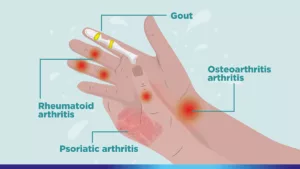
Different types of arthritis in hands
Arthritis in hands often results in discomfort, oedema, stiffness, and deformity. As arthritis worsens, it becomes harder to do daily duties with your hands than it once was.
What are the different types of arthritis that affect the hands?
Osteoarthritis: The most prevalent form of arthritis in hands is osteoarthritis, also referred to as “wear and tear” or degenerative arthritis. It causes the smooth, cushiony cartilage—which covers the ends of your bones—to deteriorate and wear away. Without any protection, the ends of the bones then rub against one another, eventually resulting in pain, stiffness, and loss of movement. The joints in your wrist, the base of your thumb, and the middle and top (near fingernails) of your fingers are the ones that experience osteoarthritis the most frequently.
For understanding the difference between osteoarthritis vs rheumatoid arthritis, click here.
Rheumatoid Arthritis: Rheumatoid arthritis is an autoimmune condition that arises when your immune system erroneously targets your own body’s tissues. RA is a chronic auto-inflammatory condition that affects more than just the joints. The illness can harm a range of body systems in some people, including the skin, eyes, lungs, heart, and blood vessels.
For understanding the difference between psoriatic arthritis vs rheumatoid arthritis, click here.
Psoriatic arthritis: Some persons who have psoriasis, a condition that results in red areas of skin covered in silvery scales, may get psoriatic arthritis. Most patients get psoriasis years before they are given a psoriatic arthritis diagnosis. Yet, for some people, joint issues start either concurrently with or before skin patches develop.
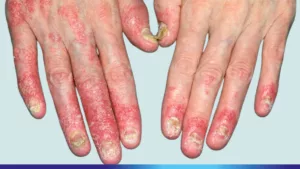
Psoriasis and arthritis in hands = Psoriatic arthritis
Symptoms of arthritis in hands
Some of the early signs and symptoms of arthritis in the hands include:
- Dull or burning pain in your joints after hours or days after increased hand use.
- Hand ache and stiffness in mornings.
- The joints in your hands and fingers are swollen.
- When you bend your fingers, you will hear grating, grinding, cracking, or clicking (crepitus).
- Your fingers are unable to fully open and close.
- The top joints of your fingers or the middle joints of your fingers can develop small bony nodules known as Bouchard’s nodes or Heberden’s nodes.
- Your finger joints enlarge, transform, and bend abnormally, weakening your hands and decreasing your ability to carry out daily tasks.
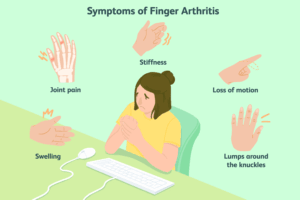
Symptoms of arthritis in hands
If you’ve been suffering from arthritis in your hand(s) for some time, symptoms that appear more frequently are:
- The pain can range from a dull ache to sharp pain.
- Pain can keep you awake at night.
- Pain may cause you to alter how you use your hand (s).
- The tissue around your affected joint may turn red and tender to the touch.
Treatment for joint pain and stiffness
The goals for the treatment of joint pain & stiffness are usually to:
- Reducing joint pain and stiffness.
- Increasing your mobility and function.
- Improving the quality of life.
- Delaying the disease progression in the case of rheumatoid or psoriatic arthritis
Splinting/bracing, medicines, injections, non-drug treatments, and surgery are all treatment options.
- NSAIDs (nonsteroidal anti-inflammatory drugs): NSAIDs can help decrease swelling, inflammation, and discomfort. These can be taken orally as well as topically. Some popular examples of NSAIDs include ibuprofen, diclofenac, naproxen, and celecoxib.
- When NSAIDs do not work or are not appropriate, your doctor may provide corticosteroid injections. In this type of treatment, shots of hydrocortisone are used to treat painful or swollen joints caused by arthritis or swelling from an accident. The aching joint receives a direct injection of hydrocortisone (this process is called intra-articular injection). The shoulder, elbow, knee, hand, wrist, and hip joints are those areas that get corticosteroid shots more frequently.
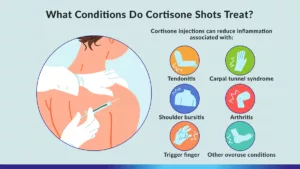
Treatment for joint pain and stiffness – corticosteriod shots
- Disease-modifying anti-rheumatic medications (DMARDs): Physicians may use DMARDs to treat rheumatoid arthritis. The most popular traditional DMARDs are leflunomide, hydroxychloroquine, methotrexate, and sulfasalazine. Other medications like azathioprine are used considerably less often. DMARDs aid in the treatment of autoimmune diseases.
- Splinting: Splinting can provide support and alleviate stress on the joints. Splints typically allow patients to move and utilise their fingers. Ring splints can provide assistance for those who have arthritis in their fingers.
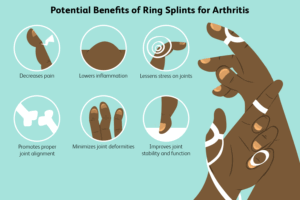
Treatment for joint pain and stiffness – Splinting for support
- Surgery: If the joint injury is serious enough, surgery may be the only choice. Joint replacements alleviate pain and restore joint function, whereas joint fusions alleviate pain but remove joint function.
Some home remedies may be beneficial:
- Exercises: Your doctor or physical therapist can show you how to enhance your strength and range of motion while also relieving discomfort.
- Assistive technology: Customized pens, culinary utensils, and other items with large handles may be more user-friendly.
- Heat or ice: Ice can help with swelling and discomfort. Heat, such as a warm washcloth or a paraffin bath, might help to relax tight joints.

Treatment for joint pain and stiffness – heat and ice therapy
- Treatments for the skin: When applied to aching joints, medicated lotions can provide comfort. Gels containing nonsteroidal anti-inflammatory medications (NSAIDs) are also beneficial.
- Supplements: Our First Time In India patented nutraceutical for comprehensive joint care is clinically proven in Osteoarthritis & Rheumatoid Arthritis.
Arthritis Supplements – OVO-JOINT
Medcell Pharma introduces OVO-JOINT – First time in India combination of patented molecules with 3 international collaborations: Ovomet® (Eggnovo from Spain), MyrLIQ® (Biosfered from Italy) and ch-OSA® (BioMinerals from Belgium) fortified with Sodium Hyaluronate.

OVO-JOINT for Joint Health Care – Osteoarthritis Treatment and Osteopenia Treatment
Star ingredients of OVO-JOINT:
- Myrliq®(Commiphora Myrrha Extract ) is naturally centrally acting analgesic which offers significant pain reduction within 2-3 days with excellent safety profile.
- OvoMet®(Collagen hydrolysate) is standardized and clinically proven in the management of osteoarthritis showing significant reduction in joint pain/ joint dysfunction in 3 days.
- ch-OSA®(Choline Stabilised Orthosilicic Acid) is an endogenous collagen generator that helps in strengthening cartilages.
- Sodium Hyaluronate is a core component of synovial fluid and helps in increasing joint lubrication & intrinsic cartilage repair mechanism.
Medcell Pharma’s OVO-JOINT is available all over the Indian sub-continent through TATA 1mg online pharmacy.
Summary
Arthritis in hands is a common condition that affects people of all ages, races, and sexes. The most common form of arthritis is osteoarthritis, while other types are Rheumatoid & psoriatic arthritis.
Symptoms of arthritis in the hands include dull or burning pain, hand ache and stiffness, swollen joints, grating, grinding, cracking, or clicking (crepitus), and small bony nodules known as Bouchard’s nodes or Heberden’s nodes.
Treatment for joint pain and stiffness includes NSAIDs (nonsteroidal anti-inflammatory drugs), splinting/bracing, medicines, injections, non-drug treatments, and surgery. Home remedies such as exercises, heat or ice, medicated lotions, and NSAIDs are also beneficial. One such home remedy can be the dosage of OVO-JOINT –> a patented nutraceutical for comprehensive joint care that is clinically proven in Osteoarthritis & Rheumatoid Arthritis.


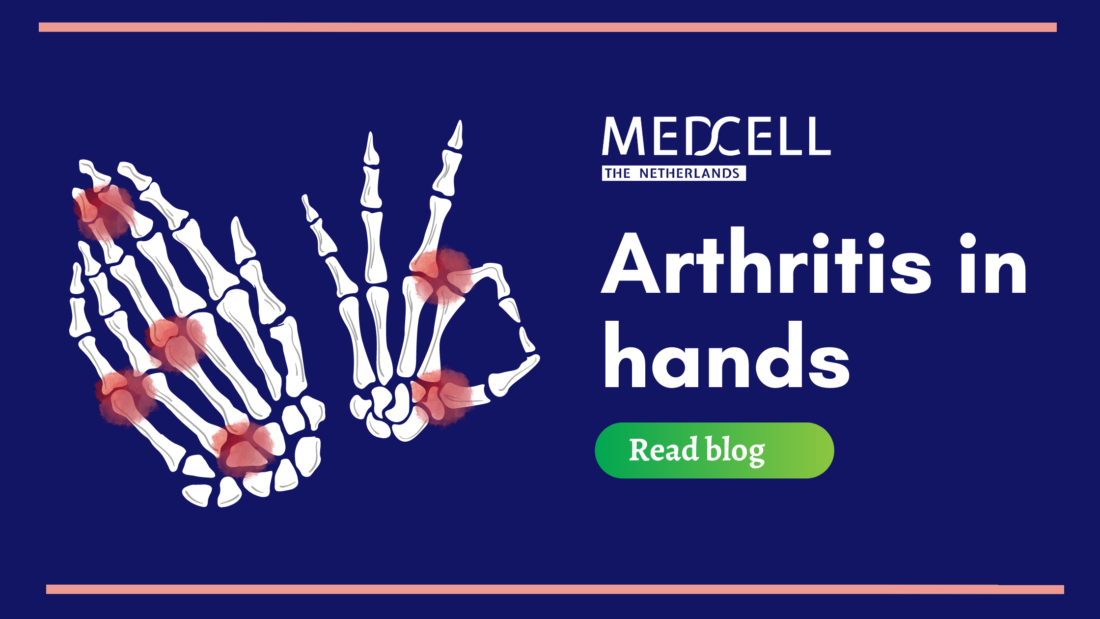
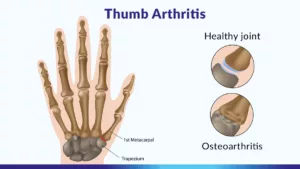
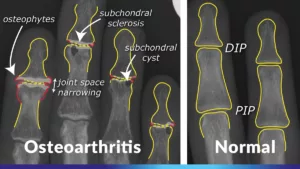
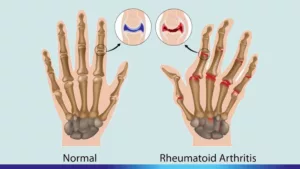

l’artrite alle mani è una malattia molto paralizzante, il tuo lavoro quotidiano ne risente moltissimo
I stumbled upon this I have discovered It absolutely useful and it has aided me out loads. Great job.